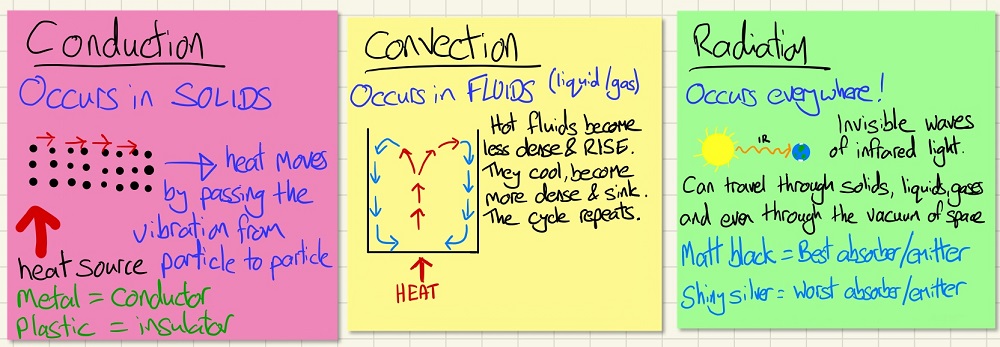Energy
What we are learning:
Energy stores and transfers:

When there are changes inside a closed system, the energy may move from one store to another. When a coal fire is burning, energy that was in the chemical store is transferred into the thermal store, as a bicycle slows, kinetic energy is transferred into the thermal store in the brakes and wheels. These transfers can be given values, the main example is work done, in the equation:
Work done (J) = Force (N) x distance moved in the direction of the force (m)
W = F s
Heat and specific heat capacity:

Temperature is a measure of "hotness" whereas heat is a measure of the amount of thermal energy. Two objects of the same mass and same temperature can contain very different amounts of thermal energy. We can calculate these using a specific constant for each material. This is the specific heat capacity, it tells us how much energy is needed to heat 1 kg by 1°C. Note that in Chemistry, you are more likely to see it a heating 1 g by 1°C. The formula is:
Energy change (J) = Mass (kg) x Specific heat capacity (J/kg°C) x change in temperature (°C)
ΔE = m c ΔΘ
This gives you the opportunity to complete the required practical in which you can calculate the specific heat capacity of materials and also compare them to literature values which gives you the opportunity to look for experimental errors and ways to improve them. You can also apply this knowledge to situations around you. Why is the sand on the beach a higher temperature than the sea right next to it? Why when you bite into an unnamed fast food chain's apple pie does the pastry feel warm but the filling feel like it has just come out of a volcano when they were in the same temperature fryer?
Power and energy transfer:

We can quantify the amount of energy in certain energy stores. The change in gravitational potential energy can be calculated using:
Change in gravitation potential energy (J) = mass (kg) x change in height (m) x gravitational field strength (N/kg)
Ep = m g h
When an object is moving, there is energy in the kinetic energy store, this too can be calculated using this formula:
Kinetic energy (J) = 0.5 x mass (kg) x velocity2 (m/s for velocity which is then squared)
Ek = ½ m v2
This is very similar to how you work out how much energy is stored in a stretched spring:
Elastic potential energy (J) = 0.5 x spring constant (N/m) x extension2 (m)
Ee = ½ k e2
Power is the rate at which energy is transferred. The basic unit is a watt (W) and 1 watt = 1 joule/second. This means that in a 10W bulb, 10 joules of energy are transferred from the electrical store every second. Power is the amount of energy transferred/time taken. P=E/t. As work done is an energy transfer too, power is also work done/time taken or P=W/t.
Conservation of energy:

In a closed system, no energy can get in and no energy can get out. The energy within can move from one energy store to another but the total energy at the start always equals the total energy at the end. This might not always be obvious but it is always true. Many people assume that when a car comes to a stop, the kinetic energy that it did have has now simply gone. Energy does not just disappear. In this case, the energy has been transferred to heat in the brakes and tyres.
Heat energy is transferred in one of three ways:
1) Conduction. This occurs through a solid that is a conductor, it has a high thermal conductivity such as a metal.
2) Convection. This occurs in fluids (liquids or gases). Hotter particles expand, become less dense so rise through the rest then cool, contract, become more dense and sink again.
3) Radiation. This is heat travelling as an invisible electromagnetic wave. This is the infrared waves and they arrive from the Sun and are emitted by the little metal bars in your toaster. These waves don't need solids, liquids or even gases, they can travel through the vacuum of space.
In order to reduce heat loss, particularly in your home while energy prices are as high as they have been, we need to stop these three methods of heat transfer as often as possible. This diagram shows examples including cavity wall insulation, loft insulation and double glazing.
Energy efficiency:

Energy efficiency is a measure of how much of the energy you start with is transferred to a useful energy store. The formula for percentage efficiency is:
(Useful energy output / total energy input) x 100 = percentage efficiency.
Devices that have a low efficiency are a problem as energy is expensive and wasted energy is disastrous to the environment if fossil fuels were used in the process. Devices at home will have a rating from A* to G. The efficiency of devices can be improved by a variety of methods ranging from better insulation to prevent heat loss (ovens) or heat gain (freezers) to better lubrication (axle bearings on wheels of cars and bicycles).
Efficiency can be shown as a decimal, a percentage or as a Sankey diagram as shown.
Energy resources:

There is a huge amount in this one little component, however, once you delve into it, you will see that they are closely linked and it will help you to connect them and remember them.
These are the resources that provide the energy that we need. We need heat, light and somewhere to charge our phones. Oh, and cook food, transport things etc. There are two main categories of these, renewable and non-renewable energy resources. For it to be renewable, we must have a realistic method of regenerating it. Renewable sources are:
• Solar (anything from the sun)
• Tidal
• Waves
• Geothermal
• Wind
• Hydro-electric
• Bio-fuels (not just pig manure, think about wood as trees can be re-planted
.
Non-renewable resources are simply gone when we have used them up and we rely too much on fossil fuels like gas (methane) to generate electricity. When we have used it up, there will be nothing for future generations, it is unsustainable. The main non-renewable energy sources are:
• Coal, gas & oil (fossil fuels)
• Nuclear (it may not release CO2 but when it has decayed, it sill not longer work.
The big question is, why do we still use fossil fuel and nuclear energy when there are so many alternatives? The answer is fairly obvious when you think about each one. We need to have the TV working when Darts is on TV, the oven must work when the roast is cooking and we want the lights to work when it goes dark. This means that there is both a fluctuation in demand (millions of kettles simultaneously go on during the advert break of the most popular TV shows) and it is needed more at different times of the day and days of the week. Here are the problems:
• It isn't always windy enough to drive wind turbines.
• Low rainfall affects hydro-electric plants and not all countries have enough rain.
• Solar panels are useless at night.
• Solar panels are almost useless when it is cloudy or rainy.
• The waves on the sea can be very gentle some days.
This means that, although we have these, when shops, businesses and factories are all working hard, we have to start the fossil fuel power stations up to fill the gap between what green electricity is provided and what the country needs.
Key words/terms for this topic
Absorb Biofuel Carbon neutral Chemical energy Closed System Conduction Conservation of Energy Convection Dissipated Efficiency Elastic Potential Electrostatic Attraction Environmental impact Fossil fuel Geothermal Gravitational Potential Hydroelectric Kinetic Lubrication Magnetic Non-renewable Nuclear Potential Power Reliability Renewable Specific Heat Capacity Streamlining System Thermal Thermal conductivity Thermal insulator Thermal Radiation Work Done
Curriculum Health Check:
Q: When a rollercoaster car is at the highest point of the track and stationary, waiting to start, what are the proportions of GPE and KE?
A: KE = 0.5 x GPE
B: Maximum KE and Minimum GPE
C: GPE is equal to KE
D: Maximum GPE and Minimum KE
What you need to know
You need to know the main types of energy stores such as kinetic, thermal and gravitational potential. Within a system, you need to be able to describe energy transfers such as chemical to thermal.

Note that energy can be transferred or dissipated but it cannot be created or destroyed.

You need to be able to calculate changes in energy due to heating, work done by forces and the work done when current flows through a conductor. You need to calculate the change in energy for:

A moving object (kinetic energy): Ek = ½m v2

A stretched spring (elastic potential): Ee = ½: k e2

Lifting from ground level (change in GPE): Ep = m g h

Heat energy transfer can be measured by using the temperature change of a substance and its specific heat capacity (the measure of how much energy is needed to change its temperature). ΔE = m c ΔT

Change in energy = mass x specific heat capacity x change in temperature.

Power is the rate at which work is done, it is simply the work done in joules (or energy transferred) divided by the time taken in seconds. P=E/t

Finally, efficiency. This is a measure of how much of the energy put into s system is transferred into a useful store.

Efficiency = useful output/total input

This topic needs you to understand the main sources of energy used today. There are fossil fuels (coal, gas, oil), nuclear fuels and renewable sources such as wind, hydroelectric, geothermal, tidal, waves and solar.

Renewable energy sources are being replaced as we use them (e.g. more sunlight is arriving from the sun or if you plant more trees than you cut down and burn).

You need to be able to describe the sources, say if they are renewable or non-renewable (nuclear is non-renewable by the way), compare outputs, efficiency and pollution etc and discuss reliability. You may have graphs and data to interpret.

Patterns in usage (half time of the FA cup final, millions of kettles go on), describing the environmental effects and why people may be opposed to wind farms or nuclear power stations.

Extra topics needed for the Higher Tier papers:

Students sitting the higher paper need to describe ways of increasing the efficiency such as lubrication to overcome friction and prevent energy being wasted as heat.

This page was updated on: 2nd April 2024

